I’ve worked in the B2B SaaS affiliate marketing space for 1.5 years and here’s my take on it: Affiliate marketing is not for the weak.
It demands a lot of time, effort, and dedication to succeed. But the challenge is what makes it rewarding.
The key to making it worthwhile? Using strategies to maximize your return on investment in your brand. Here are some core strategies we discuss with our affiliates that help them increase revenue.
Top 4 Affiliate Marketing Strategies to Maximize ROI
1. Humanize your brand.
Even though we work in the B2B space, we‘re still speaking to people — not businesses. Treating your audience as just another transaction isn’t going to set you apart from others.
People respond better to more personal and relatable interactions because those types of interactions tap into our innate desire for connection.
“Your audience is made up of individual people with their own interests and needs. By humanizing your brand and focusing on authentic, personal interactions, you can create meaningful connections that drive better results. says Lynsey Mc Hugh, Senior Affiliate Manager at HubSpot.
“Understanding your audience’s perspective and tailoring your approach to resonate with them on a more personal level can really make all the difference in maximizing your ROI.”
Let’s talk about how you can humanize your brand.
Use AI but don’t fully depend on it.
AI is one of the biggest tech advances we’ve seen in decades, which makes people feel a type of way. Some people are fascinated and excited, while others are apprehensive and skeptical. Many are both.
In a recent HubSpot study, 76% of business professionals suggested that, “People should use AI/automation in their role, but they should avoid becoming overly reliant on it.”
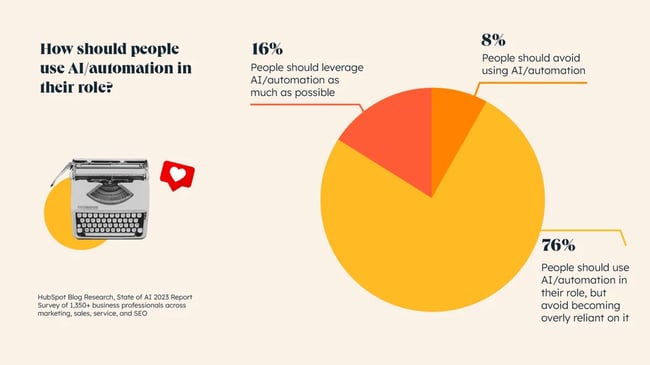
AI enables humans to do their work, no doubt. But it shouldn’t be used to do all of our work for us.
To be a successful affiliate marketer, your audience has to care about what you have to say. You can develop a loyal audience by engaging and connecting with them through your experience, wisdom, and creativity — all of which AI lacks.
Another consideration is that AI makes mistakes. It can output false information without you even knowing it. You’re playing a dangerous game if you rely solely on AI-generated content without verifying its accuracy.
So, how should you use AI in affiliate marketing? We encourage our affiliate partners to use AI for tasks like:
- Brainstorming
- Generating content outlines
- Writing catchy headlines
- Rewriting existing content for different platforms
AI can give you an extra boost when you’re hitting a wall, but it’s in your hands to create something that’s truly unique and valuable. All great things take time and AI simply helps us do our work faster.
Experiment with products and share your findings.
When you have personal experience with a product, it enhances your credibility and authenticity as an affiliate marketer.
Your recommendations carry more weight because your audience knows you have used and benefited from the product yourself.
This is why social proof like user reviews, case studies, customer testimonials, statistics and data-backed resources are so effective in the B2B SaaS market.
Social proof allows real users to share their stories, which can be incredibly persuasive when those stories reflect satisfaction with a company’s products.
We encourage our affiliate partners to test out the HubSpot customer platform and document their usage of our software. They may consider creating content that discusses:
- How I overcame this business challenge using HubSpot
- How I achieved all-time-high goals using HubSpot
- Why I like HubSpot more than a competitor’s solution
These prompts also support our affiliate partners’ E-E-A-T strategy (Experience, Expertise, Authority, and Trust) which can impact how their content ranks in search.
The E-E-A-T principles are included in Google’s Search Quality Rater Guidelines, which is a handbook used by Google to assess the quality of a website‘s content. It’s Google’s attempt to make sure your content is valuable and helpful to users.
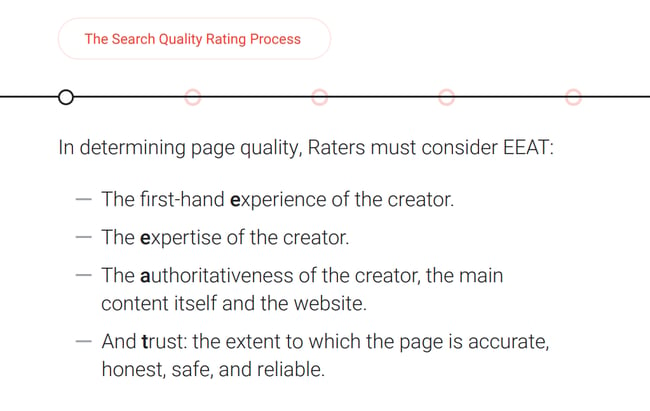
The “experience” element of the E-E-A-T guidelines highlights the importance of including relevant and personal experience in your content if you’re looking to drive more traffic to your website.
Dorissa Saint-Juste, Senior Affiliate Manager at HubSpot, likes to emphasize the significance of providing a unique perspective that differentiates your content from company websites, other marketers’ blogs, or typical reviews.
“What sets you apart? Sharing your own personal experience with a product is a valuable approach. With prospects already leaning toward a product choice, they need less convincing compared to those searching broader terms, which makes your job a little easier,” Dorissa says.
Giving your content a human touch with anecdotal evidence will improve the discoverability of your content, build trust with your audience and compel them to buy the products you promote.
2. Optimize your website.
Not every B2B affiliate marketer has or needs a website, but most do because it serves as a central hub for their online presence and marketing efforts.
But simply having a website doesn’t do you any good if it’s not optimized for SEO and the user experience. Strategically organizing everything on your website makes sure that your content is easily accessible, coherent, and valuable for your audience.
“Imagine your website is a well-organized library. Tidy shelves, clear signage, and easy navigation make it enjoyable for visitors to find the information they need,” says Rex Gelb, Senior Director of Paid Acquisition and Affiliate Manager at HubSpot.
“Just like you wouldn‘t want to search for a specific book in a chaotic and disorganized library, users don’t want to navigate through a cluttered website. Keep your digital library in order for a seamless user experience.”
Website optimization through organization can be broken into two parts:
- How your website’s content is interconnected
- How the individual pieces of your content are created
Site Structure
At the macro level, organization refers to the structure of a website. By organizing your content in a logical manner, you provide a clear roadmap for visitors to enjoy exploring your site and find the information they need.
Plus, a well-organized website enhances your SEO, helping search engines index and rank your content.
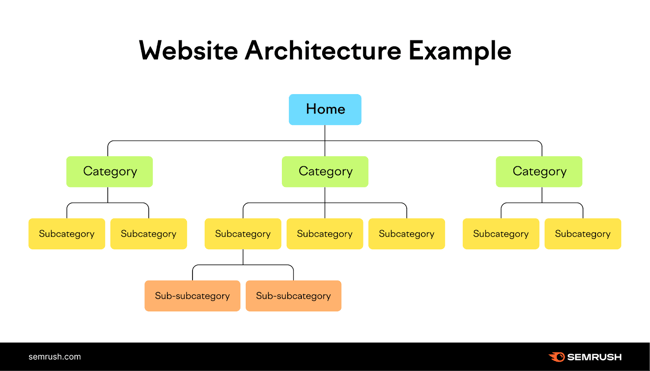
You’re doing yourself a major disservice if your website lacks thoughtful organization.
You might have the exact information that someone is looking for, but if they can’t find it quickly and easily, they’re going to leave your website without converting.
Whether you publish blog posts, videos, courses, or ebooks on your website as part of your content strategy, you should consider using categories.
What does this look like in real life? Let’s use this blog you’re on right now as an example.
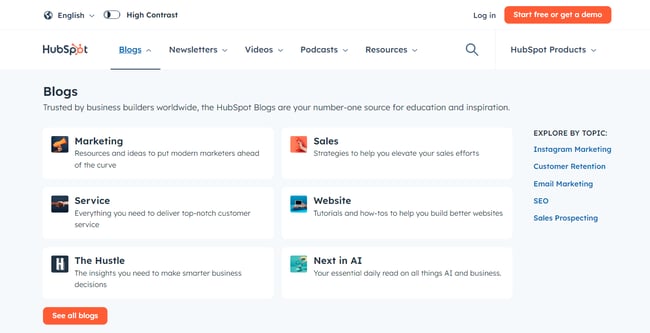
HubSpot’s blog homepage provides a navigation menu that gives each type of content its own dropdown menu.
For example, the “Blogs” tab offers several categories to choose from. These categories group content related to the same topic into one bucket. Visitors can even explore more granular topics if they’re looking for something specific within a category.
It’s almost impossible to provide a positive user experience without easy navigation. As a matter of fact, when Clutch surveyed 612 people, 94% of them said easy navigation is the most important website feature.
Don’t underestimate logical categorization and intuitive user pathways when growing and managing your website’s content.
Content Structure
Organization matters at the micro level of content creation just as much as it does at the macro level.
How you organize your thoughts can determine whether visitors stay on your site or leave without ever looking back.
How can you make every piece of content a masterpiece, you may ask? By focusing on these three elements:
- Skimmable: Make your content quick and easy to digest to adapt to people’s shorter attention spans.
- Quotable: Provide valuable and memorable information that visitors will want to share with others.
- Actionable: Define the next steps you want visitors to take after consuming your content.
Here’s how you can implement those three principles into your written content:
- Use subheadings, bulleted lists and bolded key phrases
- Add meaningful visuals like infographics and screenshots
- Keep your paragraphs short (4 sentences max)
- Take a thought leadership approach
- Incorporate reliable statistics
- Implement concise and impactful statements
- Provide clear call-to-actions
While these general ideas of optimizing content overlap across various forms such as video or digital courses, it’s crucial to know how audiences of different platforms and mediums prefer to engage and consume content.
3. Be smart with your links.
You put in so much effort into creating content and driving visitors to that content — all with the end goal of getting as many people to click on your affiliate link and convert.
“It’s crucial to be strategic with your link placements to drive conversions effectively. By being selective in your approach, you can create a more engaging and trustworthy experience for your audience, ultimately leading to better results,” says Nancy Harnett who leads the HubSpot affiliate program.
“Remember to track performance metrics and continuously experiment with new tactics to stay ahead in the dynamic world of affiliate marketing.”
Let’s get into how you can make the most of your hard work with your links.
Use the right links.
Oftentimes, affiliate programs will provide their partners with a default affiliate link which typically routes to a generic “get started with our main product” type of page.
But if you’re promoting a brand that offers more than one product and price plan, you should use product-specific landing pages depending on where your links are placed.
The reason we recommend that our affiliate partners use standalone product landing pages rather than linking to our website is because landing pages have a single objective — getting visitors to complete a desired action.
This focused approach increases the likelihood of conversions because there is no unrelated content or exit points to distract your leads.
For example, HubSpot’s customer platform has a plethora of tools: CRM, marketing automation, email marketing, sales, help desk, website builder, and more.
Let’s say a HubSpot affiliate writes a listicle for “The Best Email Marketing Tools for Small Businesses.” They should use our email marketing affiliate landing page rather than linking to our website’s email marketing product page or using the generic “get started with HubSpot” link.
Readers on that listicle are interested in buying email marketing tools, so using the corresponding landing page makes the most sense.
Disclose your links.
Always be transparent about your affiliate partnerships, not only to maintain legal compliance but to also build credibility with your audience.
According to the Federal Trade Commission’s (FTC) Endorsement Guidelines, you must “clearly and conspicuously” disclose your affiliate relationship with a brand when affiliate links are present in your content.
What does that really mean? Your readers shouldn’t have to search high and low to see it.
For example, placing your affiliate disclosure in your website footer or somewhere in your navigation menu meets the requirement of having one. However, those placements aren’t easy to see, so they don’t meet the requirement of being displayed clearly and conspicuously.
When in doubt, your best bet is to place your disclosure before your affiliate links at the beginning of your content or as near to the links as possible.
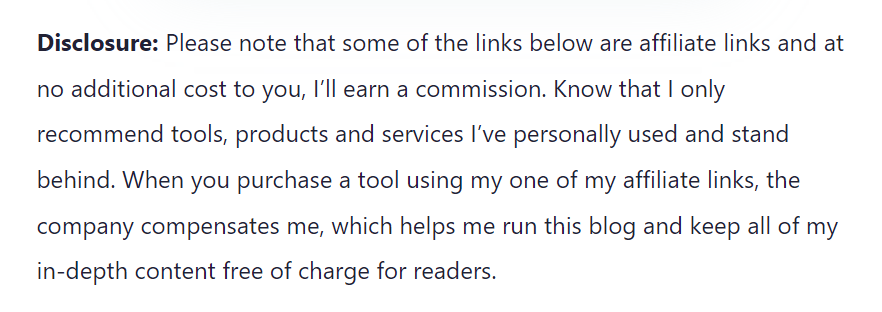
Remember, you should be disclosing your affiliate links wherever they are present so that includes social media posts, too. Our affiliate partners like to do this by adding a hashtag to their post such as #HubSpotaffiliate or #ad.
Be selective and intentional.
If you provide too many links, it becomes harder for your audience to absorb your message.
To avoid overwhelming your audience, focus on relevant and contextual link placement. Place your affiliate links naturally within your content where they will be genuinely helpful.
Putting too much emphasis on your links can be off-putting and steer visitors away. Nobody likes anything spammy.
If all your content looks like this, then you might want to rethink your link placements:

Track performance and try new things.
At the end of the day, successful affiliate marketing comes down to maximizing your outputs given your inputs (how much money you’re making from your promotional activities).
This is why analyzing performance metrics like your click-through rates (CTR), conversion rates (CVR), and traffic sources is so important. This data helps you identify which links and strategies are working well, so you can optimize your efforts for better results.
Have fun with it. Try testing out different types of content, calls-to-action, and promotion channels to see what works best.
4. Target high buyer intent keywords.
When someone enters a search query into a search engine, their intent can vary.
Some searches are purely informational, seeking general knowledge or answers to specific questions. These users aren’t actively looking to buy anything.
Other searches are driven by buyer intent. These users are actively looking to buy a specific product. They have a clear purpose and are more likely to convert.
Dorissa says, “Targeting high buyer intent keywords is a crucial strategy that every affiliate marketer should prioritize.”
She continues, “By customizing your content to meet the immediate needs of your audience and offering valuable insights and recommendations that align closely with their search intent, you can effectively capture their attention when they are ready to make a purchasing decision.”
You can attract users who are closer to making a purchase by identifying and targeting keywords with strong buyer intent. For B2B, these keywords usually include specific product names and terms like:
- Best
- Top
- Review
- Rating
- Comparison
- Vs
- Alternatives
- Demo
- Integration / works well with
The key to optimizing your content for high buyer intent searches is understanding who you’re trying to reach.
“Tailoring your content specifically to different customer segments can significantly improve engagement and drive conversions. Through this strategy, you can attract better qualified leads and achieve higher conversion rates, ultimately maximizing your earning potential,” Dorissa says.
The Search Engine Journal outlines just how to execute this strategy with the following tips:
- Use empathy to identify the paint points, needs, and preferences of potential customers.
- Find out which search queries are currently driving traffic to your site and resulting in conversions.
- Investigate the search queries people make within your target market.
- Lean on your sales and customer service teams’ expertise (if you have them).
- Read comments on relevant YouTube videos, online forums, and social media posts to learn more about your target audience’s motivations and challenges.
Once you gain insight into the intent behind search queries and optimize your content accordingly, you’ll be on your way to driving more conversions.
The Power of The Helpful Approach
What is the common theme among all four strategies we discussed?
They put your audience first.
As an affiliate marketer, you must take a value-first approach rather than a sales-first approach. Being helpful by educating, inspiring and building trust with others is a proven recipe for maximizing ROI.


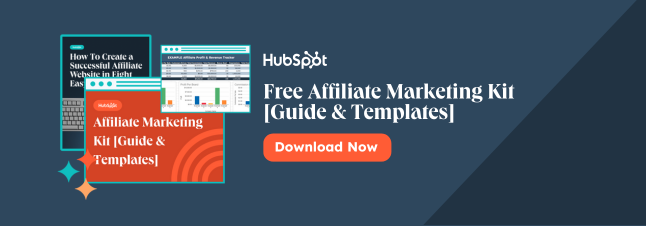
-2.png#keepProtocol)

![How to Optimize for Google’s Featured Snippets [Updated for 2024]](https://moz.com/images/blog/Blog-OG-images/How-to-Optimize-for-Googles-Featured-Snippets-OG-Image.png?w=1200&h=630&q=82&auto=format&fit=crop&dm=1724004002&s=13df73104762982790dab6dc8328023f)


